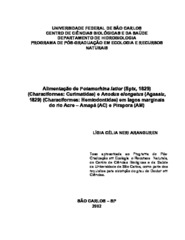| dc.contributor.author | Aranguren, Ligia Célia Neri | |
| dc.date.accessioned | 2016-06-02T19:30:15Z | |
| dc.date.available | 2004-08-10 | |
| dc.date.available | 2016-06-02T19:30:15Z | |
| dc.date.issued | 2002-05-09 | |
| dc.identifier.citation | ARANGUREN, Ligia Célia Neri. Alimentação de Potamorhina latior (Spix, 1829) (Characiformes: Curimatidae) e Anodus elongatus (Agassiz, 1829) (Characiformes: Hemiodontidae) em lagos marginais do Rio Acre-Amapá (AC) e Pirapora (AM).. 2002. 154 f. Tese (Doutorado em Ciências Biológicas) - Universidade Federal de São Carlos, São Carlos, 2002. | por |
| dc.identifier.uri | https://repositorio.ufscar.br/handle/ufscar/1866 | |
| dc.description.abstract | This study analyzesthe feeding habits and behavior of Potamorhina latior (Spix, 1829) (Characiformes: Curimatidae) and Anodus elongatus (Agassiz, 1829) (Characiformes: Hemiodontidae) in two oxbow, of the river Acre, the Amapá lake in the state of Acre and Pirapora lake in the state of Amazonas. During the period from March os 2000 to April of 2001, fish samples in the two lakes were taken and their stomach contents analyzed in order to determine their feeding habit, the preferred items in their diets, the quantitative dynamics of feeding and the similarity between the two species diets, and also to verify the relation of their diets with the seasonal variations of abiotic factors and pluviometric variations. The results showed strong differences in the diets of the species. According to the analyses of feeding frequencies, volume and indices, Potamorhina latior preferred debris followed by algae and invertebrates in the two environments both during the dry and flooding seasons. Debris represented 90% of the stomach contents, and the species can be classified as detritivorous. The same analyses carried out with Anodus elongatus revealed that the items that presented the highest frequencies in occurrence and volume were algae and zooplankton in the two lakes during both seasons, which leads to classifying the species as planktivorous. According to the distribution of algae, Euglenophyceae and Cyanophyceae predominate in the Amapa lake, while Euglenophyceae and Cholophyceae predominated in the Pirapora lake. In the case of zooplankton , Rotifera was the most representative. Spatial and seasonal variations in the diets of both species revealed little relevance, and the oscillation in the proportion of feeding items were related with their availability in the environment. Intensive feeding activity was observed in the flooding period | eng |
| dc.description.sponsorship | Universidade Federal de Sao Carlos | |
| dc.format | application/pdf | por |
| dc.language | por | por |
| dc.publisher | Universidade Federal de São Carlos | por |
| dc.rights | Acesso Aberto | por |
| dc.subject | Peixes | por |
| dc.subject | Alimentação de peixes | por |
| dc.subject | Influências ambientais | por |
| dc.subject | Lagos amazônicos | por |
| dc.title | Alimentação de Potamorhina latior (Spix, 1829) (Characiformes: Curimatidae) e Anodus elongatus (Agassiz, 1829) (Characiformes: Hemiodontidae) em lagos marginais do Rio Acre-Amapá (AC) e Pirapora (AM). | por |
| dc.type | Tese | por |
| dc.contributor.advisor1 | Peret, Alberto Carvalho | |
| dc.contributor.advisor1Lattes | http://genos.cnpq.br:12010/dwlattes/owa/prc_imp_cv_int?f_cod=K4787085A9 | por |
| dc.description.resumo | Neste estudo, foram analisados o regime e o comportamento alimentar de Potamorhina latior (Spix, 1829) (Characiformes: Curimatidae) e Anodus elongatus (Agassiz, 1829) (Characiformes: Hemiodontidae) nos lagoa marginais do rio Acre - Amapá (AC) e Pirapora (AM). Durante o período de março de 2000 a abril de 2001 foram amostrados exemplares de ambas as espécies nos dois lagos e analisados os conteúdos estomacais, com a finalidade de determinar o regime alimentar, os ítens preferenciais das dietas entre as duas espécies, a dinâmica quantitativa da alimentação, a similaridade da dieta das duas espécies e ralcionar a dieta com as variações sazonais de fatores abióticos e com as variações pluviométricas. Os resultados demonstraram diferenças marcantes no hábito alimentar destas espécies. Quando analisadas as frequências de ocorrência, frequências volumétricas e índices alimentares, Potamorhina latior mostrou preferência pelo ítem detrito, seguido de algas e invertebradosnos dois ambientes, tanto no período de seca como no período de cheia. Detrito apresentou 90% do conteúdo estomacal, permitindo a denominação detritívora. A mesma análise para Anodus elongatus revelou que os ítens alimentares que apresentaram as maiores frequências de ocorrência e volumétrica foram algas e o zooplâncton nos lagos Amapá e Pirapora nos dois períodos estudados, possibilitando a denominação planctófaga. Entre algas, Euglenophyceae e Cyanophyceae predominaram no lago Amapá e Euglenophyceae e Chlorophyceae predominaram no la Pirapora. Entre o zooplâncton, Rotifera foi mais representativo nos dois lagos. Variações espaciais e sazonais na dieta de cada espécie foram pouco relevantes e oscilações nas proporções entre os ítens alimentares foram atribuídas à disponibilidade destes no ambiente. Maior atividade alimentar foi verificada no período de cheia | por |
| dc.publisher.country | BR | por |
| dc.publisher.initials | UFSCar | por |
| dc.publisher.program | Programa de Pós-Graduação em Ecologia e Recursos Naturais - PPGERN | por |
| dc.subject.cnpq | CIENCIAS BIOLOGICAS::ECOLOGIA | por |
| dc.contributor.authorlattes | http://genos.cnpq.br:12010/dwlattes/owa/prc_imp_cv_int?f_cod=K4782667Z0 | por |
